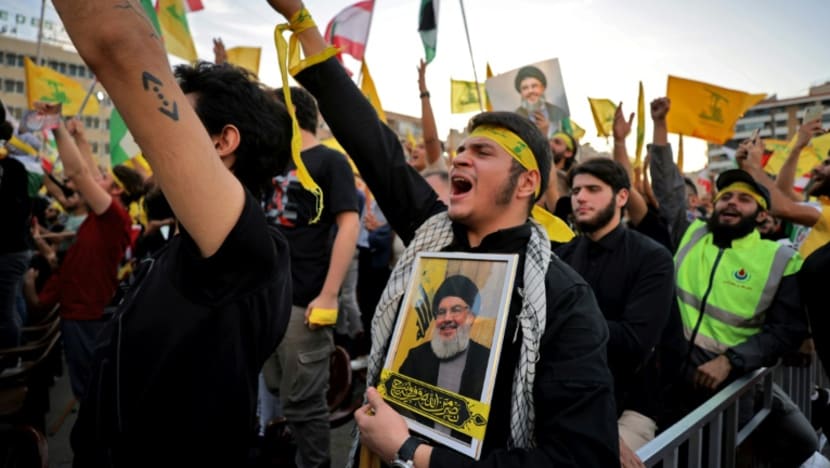How Iran-backed militant groups are widening the Israel-Hamas war

Supporters of the Lebanese Shiite movement Hezbollah wave flags and chant slogans as they watch a televised speech by its leader Hassan Nasrallah (unseen) in the Lebanese capital Beirut's southern suburbs on Nov 3, 2023. (Photo: AFP/Ahmad Al-Rubaye)

This audio is generated by an AI tool.
As the war between Israel and the Palestinian militant group Hamas continues, it has stoked violence in other parts of the Middle East.
Militant groups backed by Iran, which supports Hamas and for years has engaged in a shadow war with Israel, have joined in. They’ve attacked Israeli targets, ships in the Red Sea, and US forces, provoking retaliation.
The clashes raise concerns that a wider conflagration will engulf the region.
1. How has Iran responded to the Israel-Hamas war?
Iranian officials celebrated the Oct 7 attack that set off the war, in which Hamas fighters from the Gaza Strip overran Israeli military bases and villages, killing 1,200 people and taking about 240 hostages.
Iranian Supreme Leader Ali Khamenei said, “We kiss the hands of those who planned the attack” by Hamas, which the US and European Union consider a terrorist organisation.
Iran has denied involvement in the assault, and US and Israeli officials have said they have no direct evidence that it played an active role.
Early on, Iran said that Israel’s military response to the Hamas attack would be answered by the anti-Israeli and anti-Western groups it supports. That so-called axis of resistance includes militants in Lebanon, Yemen, Iraq, Syria and Afghanistan.
Related:
2. Why are Israel and Iran enemies?
They were allies starting in the 1950s during the reign of Iran’s last monarch, Shah Mohammad Reza Pahlavi, but the friendship abruptly ended with the Islamic revolution in Iran in 1979.
The country’s new leaders cut ties with Israel and adopted a strong stance against the Jewish state, decrying it as an imperialist power in the Middle East and supporting groups that regularly fight it.
Israel regards Iran’s potential to build nuclear weapons as a threat to its existence and is thought to be behind a campaign of sabotage against the country’s atomic program. Iran’s leaders say they have no ambition to build nuclear arms.
The Israelis point to a cache of documents their intelligence agents spirited out of Iran in 2018 that suggests otherwise. Israeli officials have repeatedly implied that if Iran were to reach the brink of weapons capability, they would attack its nuclear program using air power, as they did Iraq’s in 1981 and Syria’s in 2007.
Related:
3. Where has violence spread?
Lebanon
After the attack that set off the war, the Lebanese militia Hezbollah began launching missile, mortar and rocket strikes on northern Israel in solidarity with Hamas.
Hezbollah receives funding, weapons and training from Iran and is heavily influenced by Iran’s elite Islamic Revolutionary Guard Corps, which organises and arms militias abroad.
Cross-border fire between Israel and Hezbollah has become a daily occurrence, threatening to open a second front of the war.
Hezbollah has a bigger, more professional fighting force than does Hamas and is better armed. Israel and Hezbollah have fought repeatedly, including in a war in 2006.
The Red Sea
The Iran-backed Houthi rebels, who have controlled northwestern Yemen since civil war broke out in 2014, have launched a spate of attacks on ships plying the Red Sea.
The Houthis, who have also attempted to strike Israel with missiles and drones, say they are protesting the military campaign against Hamas by targeting any vessel with links to Israel, though no such connection was obvious for some of the affected ships.
The Red Sea attacks have prompted shipping companies to reroute vessels around the southern tip of Africa, a lengthier and costlier journey.
The US is leading a naval task force in the Red Sea to help deal with the Houthi threat. Responding to an attack on a Danish-owned container vessel, US forces sank three Houthi boats and killed several members of the rebel group Dec 31.
Iraq
US military forces in Iraq - 2,500 of whom remain in the country on a mission to prevent the resurgence of Islamic State - have been subjected to a series of attacks since mid-October.
They have been claimed mostly by an umbrella entity calling itself the Islamic Resistance, which is aligned with and backed by Iran. The US has hit back selectively.
Iraq blamed the US for a Jan 4 attack in Baghdad that killed two commanders of Harakat al-Nujaba. The group is both a constituent of the Islamic Resistance and part of Iraq’s Popular Mobilization Forces, originally formed to fight Islamic State and now part of Iraq’s security apparatus.
After a Dec 25 drone attack wounded three US service members in northern Iraq, the US struck three installations in Iraq. The operation targeted, among other groups, Kataib Hezbollah, which is separate from Hezbollah (which literally means “the party of God”) and part of the Islamic Resistance.
That strike also caused friction between the US and Iraq, whose government condemned it, saying a member of the country’s armed forces was killed.
Syria
The 900 or so US troops still in Syria - also on a counterterrorism mission - have been attacked repeatedly by militias allied with Iran.
These attacks, too, have prompted limited retaliatory strikes from the US. One on Nov 12 risked a direct confrontation between the US and Iran; the US struck facilities in eastern Syria used by Iran’s Revolutionary Guard. Syria is also a theatre of conflict between Iran and Israel.
Iran built up a military presence in Syria to support its ally, President Bashar al-Assad, in the country’s civil war and to facilitate the transfer by land of weaponry meant for Hezbollah.
On Dec 25, Iran said an Israeli air strike in Damascus killed a senior Revolutionary Guard commander. Earlier, Israel had stepped up strikes against Iran-backed militias in Syria after they moved close to the Israeli border.












